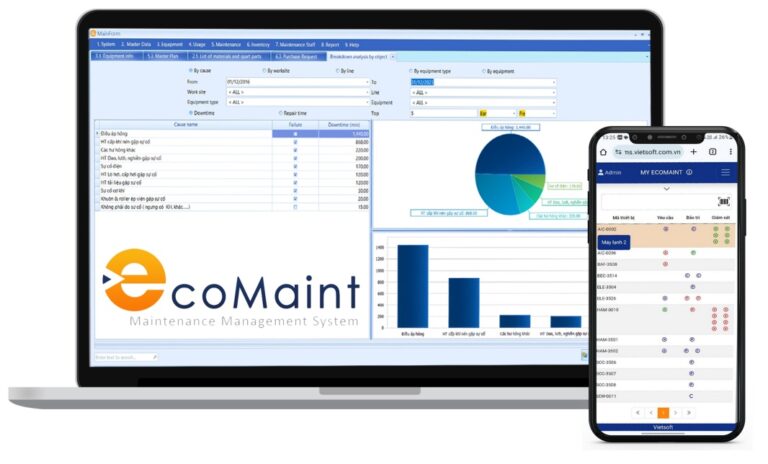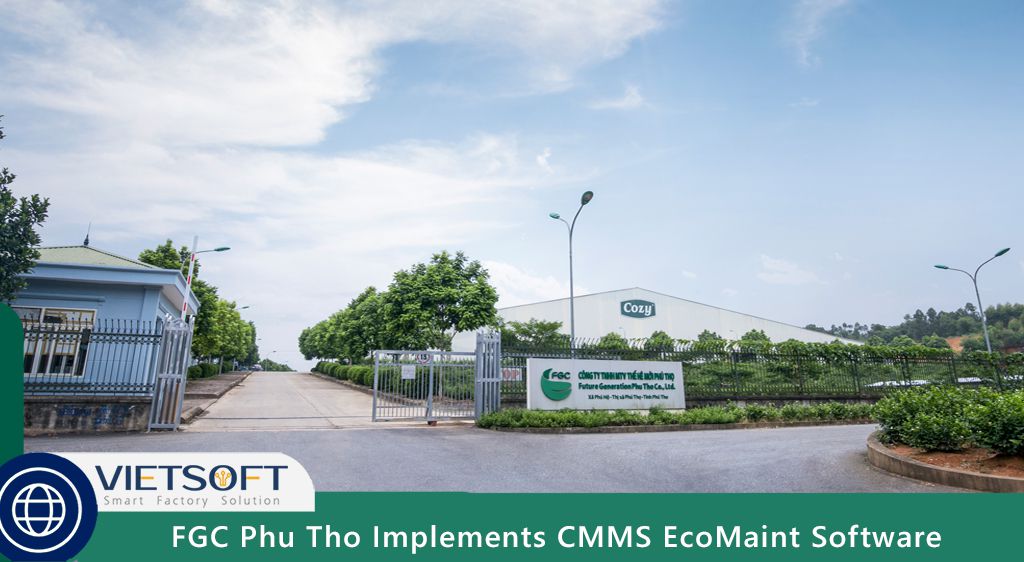
In the fast-evolving landscape of industrial operations, predictive maintenance has emerged as a game-changer, enabling companies to anticipate equipment failures, minimize downtime, and optimize operational efficiency. By leveraging advanced technologies like IoT, AI, and data analytics, Tools for Predictive Maintenance empower organizations to shift from reactive to proactive maintenance strategies. This article explores the best tools available for predictive maintenance, their roles, benefits, and practical applications, with insights tailored for maintenance professionals in Vietnam and beyond. Vietsoft’ll provide a comprehensive guide to help you select and implement the right tools for your operations.
I. What is Predictive Maintenance?
Predictive maintenance (PdM) involves using real-time data, advanced analytics, and machine learning to predict when equipment is likely to fail, allowing maintenance teams to intervene before issues escalate. Unlike traditional reactive maintenance, which addresses problems after they occur, or preventive maintenance, which follows a fixed schedule, predictive maintenance uses condition-based monitoring to optimize maintenance timing. This approach reduces unplanned downtime, lowers repair costs, and extends equipment lifespan.
Core Components of Predictive Maintenance
1. Condition Monitoring: Sensors track parameters like vibration, temperature, and sound to assess equipment health.
2. Data Analytics: Algorithms analyze historical and real-time data to detect anomalies and predict failures.
3. Machine Learning: Models learn from data to improve prediction accuracy over time.
4. Integration with CMMS: Systems like CMMS EcoMaint centralize data, automate workflows, and streamline maintenance planning.
Tools for Predictive Maintenance are critical in this process, combining sensors, software platforms, and analytical tools to monitor equipment health, detect anomalies, and recommend timely interventions. These tools are particularly valuable in industries like manufacturing, energy, and transportation, where equipment reliability is paramount.
II. Why Predictive Maintenance Tools Matter in 2025
In 2025, the global push for operational efficiency and sustainability has made predictive maintenance indispensable. According to industry studies, predictive maintenance can reduce downtime by up to 50%, cut maintenance costs by 25-30%, and extend equipment life by 20-40%. These benefits translate into significant cost savings and improved competitiveness, especially in Vietnam’s growing industrial sector.
The rise of Industry 4.0 technologies, such as IoT and AI, has further enhanced the capabilities of Tools for Predictive Maintenance. By integrating these tools with systems like Vietsoft’s CMMS EcoMaint, companies can streamline maintenance workflows, improve decision-making, and achieve measurable ROI. This article delves into the top tools, their applications, and how they can transform maintenance operations.
III. Top Tools for Predictive Maintenance
The market offers a variety of tools for predictive maintenance, each designed to address specific needs. Below, we explore the best tools, their applications, and their benefits, ensuring a comprehensive understanding for maintenance professionals.
1. IoT Sensors for Real-Time Monitoring
IoT sensors are the backbone of predictive maintenance, collecting real-time data on equipment performance. These sensors measure variables like temperature, pressure, vibration, and sound, feeding data into analytics platforms for processing.
Types of IoT Sensors
- Vibration Sensors: Detect abnormal movements in rotating equipment, such as motors or pumps, to identify misalignment or wear. For example, a vibration sensor on a conveyor belt motor can detect increased oscillation, signaling bearing wear.
- Thermal Sensors: Monitor temperature to identify overheating components. In electrical panels, thermal sensors can detect hot spots indicating loose connections.
- Acoustic Sensors: Capture high-frequency sounds to detect leaks or electrical arcing. For instance, ultrasonic microphones can identify gas leaks in pipelines.
- Pressure and Flow Sensors: Measure fluid dynamics to detect blockages or leaks in hydraulic systems.
Benefits of IoT Sensors
- Enable continuous monitoring without manual intervention.
- Provide high-accuracy data for predictive algorithms.
- Support integration with CMMS platforms like EcoMaint for centralized data management.
2. Vibration Analysis Tools
Vibration analysis is a cornerstone of predictive maintenance for rotating equipment. These tools measure the velocity, displacement, and frequency of vibrations to detect issues like misalignment, looseness, or bearing wear.
How Vibration Analysis Works
Vibration sensors collect data on equipment movement. For example, a motor operating normally produces a consistent vibration pattern. When components wear out, the pattern changes, signaling potential failure. Advanced tools compare real-time data with historical baselines to predict issues.
Key Applications
- Detecting misalignment in shafts or gears.
- Identifying bearing wear in pumps or compressors.
- Monitoring rotor imbalances in turbines.
Leading Providers
- Emerson: Offers portable and fixed vibration analyzers for industrial applications.
- Fluke: Provides user-friendly tools for quick vibration assessments.
- SKF: Known for robust sensors tailored to heavy machinery.
Why It’s Worth It
Vibration analysis delivers actionable insights within 30 days of implementation, making it ideal for industries with high-speed equipment. However, it requires trained personnel to interpret data accurately.
3. Infrared Thermography Sensors
Infrared thermography uses thermal imaging to detect heat variations in equipment, identifying issues invisible to the naked eye. These sensors are critical for electrical and mechanical systems where overheating signals potential failure.
Applications of Infrared Thermography
- Monitoring bearing temperatures in motors.
- Detecting electrical faults like arcing or loose connections.
- Assessing insulation conditions in buildings or equipment.
Benefits
- Non-invasive, allowing inspections without stopping equipment.
- Identifies issues in obscured components, such as internal motor windings.
- Reduces safety risks by enabling remote monitoring.
Providers
- Flir: Offers high-resolution thermal cameras for industrial use.
- Fluke: Provides portable thermography tools for quick diagnostics.
4. Ultrasonic Analysis Tools
Ultrasonic analysis tools detect high-frequency sounds emitted by equipment, identifying issues like leaks, bearing wear, or electrical arcing. These tools are highly sensitive and effective for early fault detection.
How Ultrasonic Analysis Works
A sensitive microphone captures sounds above human hearing range (e.g., 20 kHz). The data is converted into digital signals and compared with baseline recordings to identify anomalies.
Applications
- Detecting gas or steam leaks in pipelines.
- Monitoring bearing conditions in rotating equipment.
- Identifying electrical faults like corona discharge.
Benefits
- Low acquisition cost compared to other PdM tools.
- Easy to use, with audible feedback for technicians.
- Enables non-contact measurements, enhancing safety.
Providers
- UE Systems: Offers portable ultrasonic devices for spot checks.
- SDT: Provides advanced systems with integrated thermometers and cameras.
5. Motor Circuit Analyzers
Motor circuit analyzers assess the electrical health of motors using electric signature analysis (ESA). They measure voltage and current to detect faults in motor components.
Applications
- Identifying stator winding issues.
- Detecting rotor problems or bearing faults.
- Assessing power quality issues affecting motor performance.
Benefits
- Tests can be conducted while equipment is running, minimizing downtime.
- Provides a comprehensive view of motor health in minutes.
Providers
- Fluke: Offers compact analyzers for quick diagnostics.
- PdMA: Specializes in advanced ESA tools for industrial motors.
6. Laser-Shaft Alignment Tools
Misaligned shafts are a leading cause of mechanical failure. Laser-shaft alignment tools ensure precise alignment, reducing stress on bearings and other components.
How They Work
A laser beam measures alignment across rotating shafts, detecting angular or offset misalignments. The tool provides real-time feedback to guide adjustments.
Benefits
- Reduces mechanical failures by ensuring proper installation.
- Improves energy efficiency by minimizing friction.
- Provides documentation for compliance and maintenance records.
Providers
- SKF: Offers intuitive laser alignment systems.
- Fixturlaser: Known for high-precision tools for industrial applications.
7. Oil and Lubricant Analysis Tools
Oil analysis monitors lubricant condition to detect contamination, wear particles, or viscosity changes, providing insights into equipment health.
Applications
- Detecting metal particles indicating component wear.
- Assessing lubricant degradation in gearboxes or engines.
- Ensuring compliance with equipment warranty requirements.
Benefits
- Reduces oil consumption by optimizing change intervals.
- Provides early warnings of component failure.
- Portable options enable on-site analysis for faster results.
Providers
- Ametek: Offers portable oil analysis kits.
- Donaldson: Specializes in hydraulic oil analysis solutions.
8. Video Analysis Tools
Video analysis is an emerging tool that captures equipment movement to assess operating deflection shape (ODS). It provides visual insights into vibration patterns without requiring multiple sensors.
Benefits
- Non-contact, reducing the need for physical access to equipment.
- Provides realistic visuals for easier interpretation.
- Simplifies analysis of complex machinery.
Challenges
- Requires advanced equipment and training.
- Still evolving, with limited provider availability.
9. Drones for Visual and Thermal Inspections
Drones equipped with high-definition cameras and thermal sensors provide access to hard-to-reach areas, enhancing inspection efficiency and safety.
Applications
- Inspecting tall structures like wind turbines or cooling towers.
- Detecting heat leaks in electrical infrastructure.
- Monitoring corrosion in pipelines or storage tanks.
Benefits
- Reduces inspection costs by eliminating scaffolding or lifts.
- Enhances safety by minimizing worker exposure to hazardous areas.
- Enables frequent inspections for better data collection.
10. CMMS Software: The Heart of Predictive Maintenance
Computerized Maintenance Management Systems (CMMS) like Vietsoft’s CMMS EcoMaint integrate sensor data, analytics, and maintenance workflows to create a cohesive PdM strategy. EcoMaint centralizes data from IoT sensors, automates work orders, and provides performance analytics to optimize maintenance schedules.
Key Features of CMMS EcoMaint
- Automated Scheduling: Generates work orders based on sensor alerts or predictive algorithms.
- Equipment History: Tracks maintenance records to identify recurring issues.
- Inventory Management: Monitors spare parts to ensure availability.
- Mobile Access: Allows technicians to update tasks in real-time from the field.
- Analytics Dashboards: Provides insights into downtime, costs, and asset performance.
Why Choose CMMS EcoMaint?
CMMS EcoMaint seamlessly integrates with IoT sensors and predictive analytics, enabling maintenance teams to act on real-time insights. Its user-friendly interface and cloud-based architecture make it accessible for teams of all sizes, from small factories to large industrial complexes. By leveraging EcoMaint, businesses can reduce downtime by up to 50% and extend equipment life by 25-30%. Learn more about CMMS EcoMaint here.
Contact us via hotline: 0986778578 or email: sales@vietsoft.com.vn.
IV. Choosing the Right Tools for Predictive Maintenance
Selecting the best tools for predictive maintenance depends on your industry, equipment, and operational goals. Here’s how to make an informed decision:
1. Industry-Specific Needs
- Manufacturing: Prioritize vibration and thermal sensors for rotating equipment.
- Energy: Focus on oil analysis and drones for pipeline and turbine inspections.
- Data Centers: Use motor circuit analyzers and thermal imaging for electrical systems.
2. Cost-Benefit Analysis
Evaluate the initial investment (sensors, software, training) against long-term savings. For example, a $10,000 investment in vibration sensors can save $100,000 annually by preventing downtime.
3. Integration with Existing Systems
Ensure tools integrate with your CMMS or ERP system. CMMS EcoMaint, for instance, offers robust APIs for seamless data flow from sensors to maintenance workflows.
4.Vendor Support
Choose providers with strong training programs and 24/7 support. Vietsoft, for example, offers dedicated onboarding and ongoing training for CMMS EcoMaint users.
V. Implementing Predictive Maintenance: A Step-by-Step Guide
To successfully implement Tools for Predictive Maintenance, follow this structured approach:
1. Develop a Strategy
- Identify critical assets with high downtimeW impact or downtime costs.
- Set measurable KPIs, such as downtime reduction or cost savings.
- Create a phased implementation plan, starting with a pilot project.
2. Build Skills and Expertise
- Train technicians on sensor use and data interpretation.
- Involve cross-functional teams (maintenance, operations, IT) for holistic implementation.
- Consider external consultants for initial setup.
3. Ensure Data Quality
- Install appropriate sensors for accurate data collection.
- Establish data governance protocols for security and consistency.
- Clean and normalize historical data for reliable predictions.
4. Monitor and Optimize
- Regularly review predictive model accuracy against KPIs.
- Create feedback loops between technicians and analysts.
- Refine algorithms and maintenance thresholds based on real-world outcomes.
VI. Challenges in Adopting Predictive Maintenance Tools
While Tools for Predictive Maintenance offer significant benefits, implementation challenges include:
1. Data Privacy and Security
- Use end-to-end encryption for data transmission.
- Implement role-based access controls and regular security audits.
- Ensure compliance with regulations like GDPR or Vietnam’s cybersecurity laws.
2. Technical Limitations
- Retrofitting older equipment with sensors can be costly.
- Data quality issues, such as sensor drift, can lead to inaccurate predictions.
- Integration with legacy systems may require custom solutions.
3. Cultural and Adoption Barriers
- Resistance to change from traditional maintenance teams.
- Significant training needs for new technologies.
- Need for management buy-in to secure resources.
Solution: Start with a pilot project using CMMS EcoMaint to demonstrate quick wins, such as a 20% reduction in maintenance costs, to build stakeholder confidence.
VI. The Future of Predictive Maintenance Tools
The future of Tools for Predictive Maintenance is shaped by advancements in AI, IoT, and sustainability:
1. AI and Machine Learning
- Deep learning models will improve anomaly detection accuracy.
- Edge computing will enable real-time processing for faster responses.
- Natural language processing will simplify data interpretation for non-technical staff.
2. Smart Factory Integration
- Digital twins will enhance simulation-based maintenance planning.
- Interoperability standards will eliminate data silos.
- AR interfaces will streamline maintenance procedures.
3. Sustainability Focus
- Tools will quantify energy savings and reduced waste.
- Carbon footprint calculations will guide eco-friendly maintenance decisions.
- Optimized equipment performance will reduce energy consumption.
.
VII. Conclusion
Tools for Predictive Maintenance are transforming industrial operations by enabling proactive, data-driven maintenance strategies. From IoT sensors to AI-powered analytics and CMMS platforms like Vietsoft’s EcoMaint, these tools help businesses reduce downtime, lower costs, and extend equipment life. By carefully selecting tools that align with your industry needs, integrating them with existing systems, and fostering a culture of adoption, you can unlock significant operational and financial benefits.




